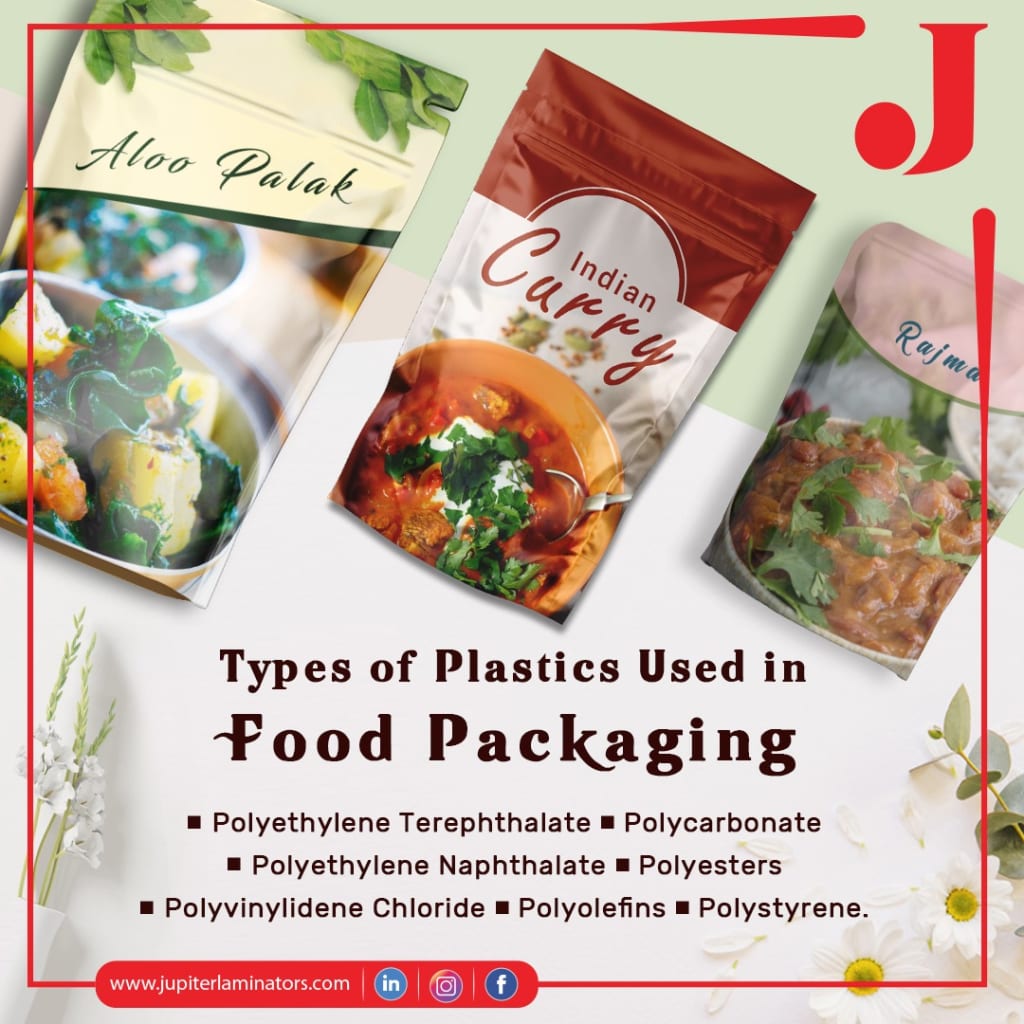Types of Plastics Used in Food Packaging
Food Packaging

Despite the safety considerations, the utilization of plastics in food packaging has continuing to extend due to the low price of materials and practical benefits (such as thermosealability, microwavability, optical properties, and unlimited sizes and shapes) over ancient materials like glass and tinplate. Multiple sorts of plastics are being employed as materials for food packaging, as well as polyolefin, polyester, polyvinyl resin, polyvinylidene chloride, phenylethylene, polyamide, and gas vinyl alcohol. Though over thirty sorts of plastics are used as packaging materials, polyolefins and polyesters are the foremost common.
Let’s look into the types of plastics used in food packaging:
Polyolefins: Polyolefin may be a collective term for polythene and plastic, the two most generally used plastics in food packaging, and alternative less common aliphatic compound polymers. Polyethylene and plastic each possess a prosperous combination of properties, as well as flexibility, strength, lightness, stability, wet and chemical resistance, and straightforward processability, and are like minded for recycling and reuse.
The simplest and most cheap plastic created by addition chemical action of gas is polythene. There are two basic classes of polyethylene: high density and low density. High‐density polythene is stiff, strong, tough, immune to chemicals and wet, leaky to gas, simple to method, and easy to make. It's used to build bottles for milk, juice, and water; box liners; oleo tubs; and grocery, trash, and retail baggage. Low‐density polythene is versatile, strong, tough, simple to seal, and immune to wet. As a result, polythene is comparatively clear, it's predominately employed in film applications and in applications wherever heat protection is critical. Bread and frozen foods baggage, versatile lids, and compressible food bottles are samples of. Polythene bags are typically reused (both for grocery and non-grocery retail). Of the two categories of polythene, high‐density polythene containers, particularly milk bottles, are the foremost recycled among plastic packages.
Polyesters: Polythene terephthalate (PET or PETE), polycarbonate, and polythene naphthalate (PEN) are polyesters that are condensation polymers fashioned from organic compound monomers that result from the reaction between acid and alcohol. The foremost unremarkably used polyester in food packaging is PETE.
Polyethylene terephthalate: Formed once terephthalic acid reacts with ethanediol, PETE provides a decent barrier to gases (oxygen and carbon dioxide) and wet. It additionally has smart resistance to heat, mineral oils, solvents, and acids, however to not bases. Consequently, PETE is turning into the packaging material of alternative for several food goods, notably beverages and mineral waters. The utilization of PETE to form plastic bottles for effervescent drinks is increasing steady. The most reasons for its quality are its glass‐like transparency, adequate gas barrier for retention of pervasion, light-weight, and shatter resistance. The three major packaging applications of PETE are containers (bottles, jars, and tubs), semi-rigid sheets for thermoforming (trays and blisters), and thin‐oriented films (bags and dish wrappers). PETE exists each as associate amorphous (transparent) and a semi-crystalline (opaque and white) thermoplastic material. Amorphous PETE has higher malleability however less stiffness and hardness than semi-crystalline PETE, that has smart strength, ductility, stiffness, and hardness. Recycled PETE from soda bottles is employed as fibers, insulation, and alternative non-food packaging applications.
Polycarbonate: Polycarbonate is made by chemical action of a metal salt of bisphenol acid with carbonyl bichloride (phosgene). Clear, heat resistant, and sturdy, it's principally used as a replacement for in close things like massive returnable/refillable water bottles and sterilizable baby bottles. Care should be taken once improvement polycarbonate because using harsh detergents like antimicrobic isn't suggested as a result, they change state of the discharge of bisphenol A, a potential health hazard.
Polyethylene naphthalate: PEN may be a condensation compound of dimethyl hydrocarbon dicarboxylate and ethanediol. It's a comparatively new member of the polyester family with glorious performance as a result of its high glass transition temperature. PEN's barrier properties for greenhouse gas, oxygen, and vapor are superior to those of PETE, and PEN provides higher performance at high temperatures, permitting hot refills, rewashing, and recycling. However, PEN prices three to four times over PETE. As a result of PEN provides protection against transfer of flavors and odors, it's like minded for producing bottles for beverages like beer.
Polyvinylidene chloride: Polyvinylidene chloride (PVdC), an addition compound of vinyl chloride, it is heat sealable and is a wonderful barrier to vapor, gases, and fatty and oily goods. It is employed in flexible packaging as a monolayer film, a coating, or a part of a product. Major applications embrace packaging of poultry, cured meats, cheese, snack foods, tea, coffee, and confectionary. It's additionally employed in hot filling, retorting, low‐temperature storage, and changed atmosphere packaging. PVdC contains twice the amount of halogen as PVC and thus additionally presents issues with burning.
Polystyrene: Polystyrene, an addition compound of phenylethylene, is clear, hard, and brittle with a comparatively low freezing point. It will be mono‐extruded, co‐extruded with alternative plastics, injection wrought, or foamed to provide a spread of goods. Foaming produces an opaque, rigid, light-weight material with impact protection and thermal insulation properties. Typical applications embrace protecting packaging like egg cartons, containers, disposable plastic tableware, lids, cups, plates, bottles, and food trays. In enlarged kind, phenylethylene is employed for non-food packaging and artefact, and it will be recycled or incinerated.
About the Creator
Jupiter Laminators
Jupiter Laminators- Largest manufacturers in flexible packaging. India’s trusted and renowned packaging company, for imparting excellent services in flexible packaging, while acquiring an impeccable reputation to all over India.






Comments
There are no comments for this story
Be the first to respond and start the conversation.